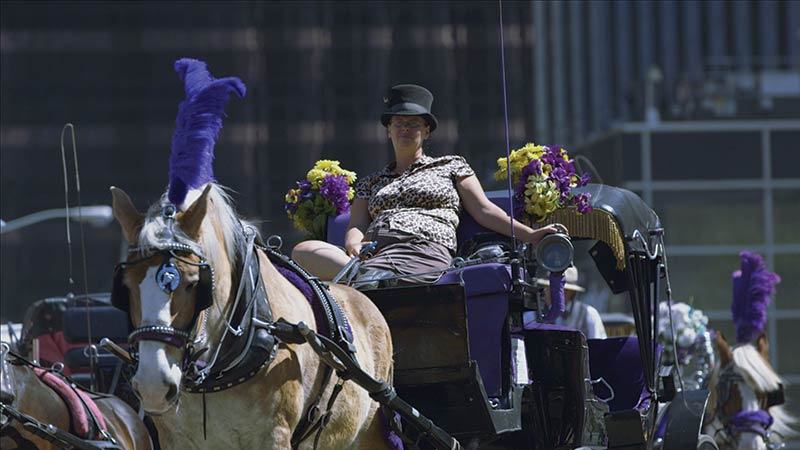 Spokesperson Christina Hansen after protest day. Photo by Mary Haverstick
Spokesperson Christina Hansen after protest day. Photo by Mary Haverstick
For 160 years, horses and carriages have been part of the city-scape in New York. As iconic as the Empire State Building (a mere 88 years old), the Statue of Liberty (143 years old), and Central Park, designed by Frederick Law Olmstead and dedicated in 1880, the carriages have been featured in films and television shows, on travel posters and in commercials.
They have trotted into a very different spotlight today. One of Mayor Bill de Blasio’s campaign promises was to shut the carriage rides down. Certain animal rights advocates jumped onto de Blasio’s bandwagon, asserting that the industry was abusive. Real estate developers, eager to repurpose the stables’ real estate in trendy Hell’s Kitchen and other prime spots in the city, joined the fray.
It seemed that all the levers of power and money were primed to banish the carriages from New York streets. Or not.
Defenders Speak Out
A few years ago, Lancaster, PA film maker Mary Haverstick commented on a Facebook post about New York’s carriage horses. Her comment elicited more comments, and soon she was in New York visiting the stables where the carriage horses live.
A group of activists, New Yorkers for Clean, Livable and Safe Streets (NYCLASS) had been campaigning to end the carriage rides; they endorsed de Blasio in his mayoral campaign and celebrated his vow to ban the carriages “on day one” of his administration. City Council, however, defeated the mayor’s efforts, and NYCLASS retreated and decided to change their plans. Instead of banning all carriages, they now want to ban the horses from areas outside of Central Park.
But the carriage drivers are represented by the Teamsters Union, and they refuse to give up their access to the city’s streets. They named two of the drivers, Christina Hansen and Stephen Malone to speak for them. Both were passionate, thoughtful and uncompromising; and not shy about directly confronting de Blasio. The group had some celebrity support as well. Actor Liam Neeson, who appears in the film, says he is committed to supporting the carriage drivers. He has been a vocal supporter of the carriage drivers on television, too, appearing on programs like The Tonight Show to advocate for the industry.
The controversary had more angles than a starburst—each worth exploring in greater depth. And so, for two years, Haverstick and her crew followed the daily lives of the carriage drivers and their horses and documented their stories. Her documentary, The Last Horsemen of New York, debuted on May 11 in Lancaster and New York.
The 79-minute film exposes the vitriol that has been directed at the carriage drivers (and their passengers), the political maneuvering that occurs when money meets lawmaking, and the passion the drivers have for their horses and their profession.
Haverstick set out to tell the story of the carriage drivers fighting for their livelihoods, and in the process, she painted a vivid picture of the many ways that money drives politics.
Strict Regulations
While activists claim that the carriage horses are abused, and they don’t receive proper care, several professional organizations disagree. The American Veterinary Medical Association, the American Association of Equine Practitioners and the New York State Veterinary Medical Society have endorsed the carriage horse industry and the care the horses receive, according to Hansen.
And the rules protecting the horses are anything but superficial. The horses cannot work more than nine hours in any 24-hour period. They cannot work for more than two hours continuously without a 15-minute break. They cannot work when the temperature is above 89 degrees or below 19 degrees. When the temperature is below 55 degrees and raining, drivers are required to provide rain sheets for the horses. In cold weather when the horses are standing and waiting for customers, they must be protected by blankets. The state mandates at least five weeks’ vacation annually for each carriage horse. The vacation must be at a farm outside the city, with daily access to pasture.
The carriage drivers and the carriages themselves are also regulated, licensed, tested and inspected.
The stables that house New York’s carriage horses include individual stalls that are at least 60 feet square, so there’s plenty of room for the horses to stand, turn, lie down, etc. There are rubber mats under the straw bedding. The stables have sprinkler systems and there is always someone on duty at the stable—24 hours a day—in case of emergencies.
The Last Horsemen of New York is available online and on VOD nationwide. It is available as Pay Per View on Dish TV and Direct TV and streaming on iTunes and Amazon.




